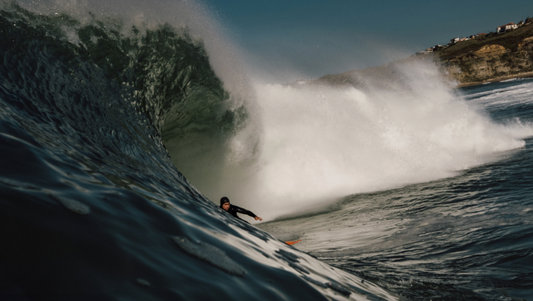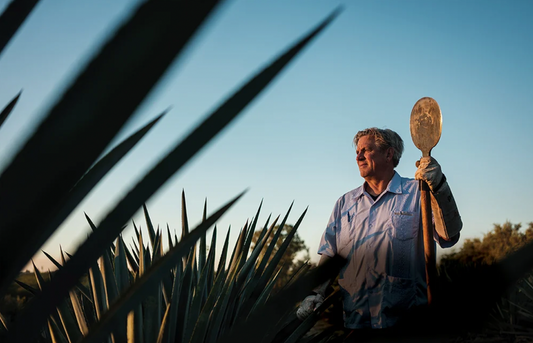An award-winning scientist, pro surfer, Native Hawaiian cultural practitioner, filmmaker and one of the 2024 Explorers Club 50 honorees — recognized as “Fifty people changing the world, the world needs to know about” — Dr. Cliff Kapono continues to make waves both in the lab and in the ocean. Blending a passion for surfing with his expertise in molecular bioscience, Cliff has produced award-winning films that shed light on critical issues like ocean conservation, global food security, and indigenous rights, all while contributing to peer-reviewed publications in his field. Profiled in The New York Times, NBC, CBS, Surfer Magazine, and the Surfer’s Journal, Cliff has also been sampling agave surfboards for the better part of a decade now. Just in from a boat trip to the Mentawais, Cliff gave us the lowdown about his thoughts on riding agave…
Agave Brothers: Talk to me about your history riding agave boards…
Cliff Kapono: I first jumped on an agave board in California. The first time was with Chad Jackson. He was making some agave boards up in Central California, and I rode one of his little fishes. It was super killer. It was a twin-pin or something and he was charging on it. He'd do airs on it, and I tried the board, too, and was like, “Wow, this thing doesn't feel like wood. After that, I ended up getting introduced to the brothers out of Laguna."
Around the world on agave.
Yeah. Ian reached out and asked if I wanted some boards. He was working with Matt Parker to create a board, and also …Lost. So, I went and grabbed a …Lost Mayhem. I think it was a Sub Driver, but made out of agave. I rode it down in San Diego, and it felt like a pretty good, normal shortboard. Then I rode another board, and it felt quite light. The board didn’t feel any less performance-y in agave, really. No less flex. I really couldn't tell too much of the difference, but that was at a beach break. It kind of felt all the same to me. I took it back, and they're like, “Hey, Matt Parker just made this board called the Ledge, and it's a 6'4," 5-fin, heavy-glass coated board for bigger waves. I grabbed that thing, and it was kinda heavy, but I ended up going to Africa with the board, and Indonesia, Mexico, Hawaii… That was like eight years ago now, maybe.
Wow. So, were you surfing that board in that one shot I’ve seen of you in Indonesia?
Yeah, that was at Padang Padang. That was a huge day. That was the year that boat flipped at Nias. I was there on a trip with Rizal, and I took that board. We also went to the Komodo Islands. But there was a day where Padang Padang was breaking, and it was high tide, nobody out. Really big, washing through. I was just out there with another guy who was on an 8’0”, and I just rode that 6’4” Album agave board. Because it was kind of bumpy and big and there was a lot of swell, the weight of that board was so good. Just the way it was absorbing the turbulence in the wave, that was probably the best thing I liked about it, and that's what I really love about the agave. It’s so cool to have another option or feel outside of PU or EPS. Because EPS can react really weirdly to turbulence on a wave.
Right, feels almost like a corrugated roof or something.
Yeah. It kind of tings in the wave, whereas if you have something like a clay roof, it absorbs that shock.
That's a good way to put it.
I ended up taking that 6’4” out to Pascuales on big day and got barreled. Everyone was on 10’0”s that day, and I was gonna tow, down where the tow zone was, but it was smaller. It was like eight feet down there. So, I was like, “Ah, you know what? I'm just gonna paddle.” So, I ended up just getting that one. And again, the board absorbed a lot of that turbulence.
Even on the smaller days, the agave board takes that turbulence well. Travis Reynolds made me a twin-fin, a Swedish Fish agave board. On water with that bumpy kind of glassiness, the agave softened that response. It kind of felt like shocks. It toned it down.
Wow. But didn’t feel slow at all?
No way. I think if an agave board feels slow somehow, it’s not the agave but the glassing. The glassing always seems to be a little bit heavier, but I don't mind a little heavier board and a little bigger board, because when I feel like things are slow, I just get a bigger wave or a board with more rail. I used to think, “Ah, this board is slow, or this board is not responsive.” But then I started to learn I was riding it in the wrong wave or the design was just not quite there. I was riding a 7’5” with Uncle Gerry down at Uluwatu on a single fin and that thing felt small, and it was just so quick. But then I took it back home to Honoli'i and it felt like it couldn’t even do a turn. So, I can't really say for sure if the agave board felt slow, but what I do know is there's a weight difference.
Like I said, I've ridden a 6’0” …Lost Sub Driver, a 6’4” Matt Parker Ledge, a 5’8” Swedish Fish Travis Reynolds, and I rode Chad's personal 5’6” or something twin agave. So, I rode four of them and I would personally want to have my boards made out of agave.
Right on. Sounds like you’re psyched on the material.
I really am a huge fan of agave. There's probably solutions to its limitations, too. But I'll be the first to start adopting them more as soon as they come. They ride insane and environmentally, they're the best thing out there right now. Truly. Agave is 100% natural. It grows fast. Chad was going through the countryside one time and grabbing them and drying them. It seems like, from an environmental standpoint, that's really something that can be scalable. They just have to make sure it lasts in the event of a ding [laughs].




